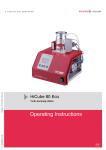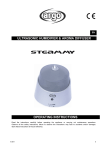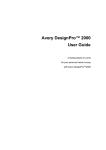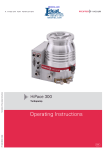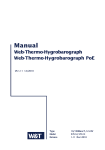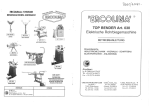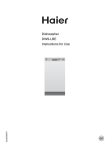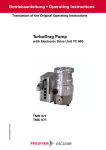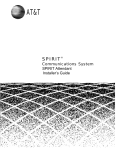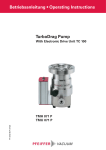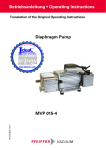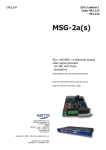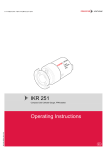Download Betriebsanleitung • Operating Instructions Turbo Pumping Station
Transcript
Betriebsanleitung • Operating Instructions Translation of the Original Operating Instructions Turbo Pumping Station PT 0264 BE/A (0901) HiCube Classic Table of contents Table of contents 1 1.1 1.2 2 2.1 2.2 2.3 3 3.1 3.2 4 4.1 4.2 4.3 5 5.1 5.2 5.3 5.4 5.5 5.6 5.7 6 6.1 6.2 6.3 6.4 6.5 6.6 6.7 7 7.1 7.2 7.3 8 8.1 8.2 8.3 9 9.1 10 11 12 12.1 12.2 12.3 12.4 13 2 About this manual . . . . . . . . . . . . . . . . . . . . . . . . . . . . . . . . . . . . . . 3 Validity. . . . . . . . . . . . . . . . . . . . . . . . . . . . . . . . . . . . . . . . . . . . . . . . 3 Conventions . . . . . . . . . . . . . . . . . . . . . . . . . . . . . . . . . . . . . . . . . . . 3 Safety . . . . . . . . . . . . . . . . . . . . . . . . . . . . . . . . . . . . . . . . . . . . . . . . 4 Safety precautions . . . . . . . . . . . . . . . . . . . . . . . . . . . . . . . . . . . . . . 4 Proper use. . . . . . . . . . . . . . . . . . . . . . . . . . . . . . . . . . . . . . . . . . . . . 5 Improper use . . . . . . . . . . . . . . . . . . . . . . . . . . . . . . . . . . . . . . . . . . . 5 Transport and storage . . . . . . . . . . . . . . . . . . . . . . . . . . . . . . . . . . 6 Transport . . . . . . . . . . . . . . . . . . . . . . . . . . . . . . . . . . . . . . . . . . . . . . 6 Storage . . . . . . . . . . . . . . . . . . . . . . . . . . . . . . . . . . . . . . . . . . . . . . . 6 Product description . . . . . . . . . . . . . . . . . . . . . . . . . . . . . . . . . . . . 7 Product identification . . . . . . . . . . . . . . . . . . . . . . . . . . . . . . . . . . . . . 8 Function . . . . . . . . . . . . . . . . . . . . . . . . . . . . . . . . . . . . . . . . . . . . . . 8 Range of application . . . . . . . . . . . . . . . . . . . . . . . . . . . . . . . . . . . . . 9 Installation . . . . . . . . . . . . . . . . . . . . . . . . . . . . . . . . . . . . . . . . . . . 10 Set-up . . . . . . . . . . . . . . . . . . . . . . . . . . . . . . . . . . . . . . . . . . . . . . . 10 Preparatory work . . . . . . . . . . . . . . . . . . . . . . . . . . . . . . . . . . . . . . . 10 Connecting the high vacuum side . . . . . . . . . . . . . . . . . . . . . . . . . . 11 Connecting the exhaust side . . . . . . . . . . . . . . . . . . . . . . . . . . . . . . 11 Connecting to the mains power supply . . . . . . . . . . . . . . . . . . . . . . 12 Connecting accessories . . . . . . . . . . . . . . . . . . . . . . . . . . . . . . . . . 12 Connecting an external turbopump . . . . . . . . . . . . . . . . . . . . . . . . . 14 Operation . . . . . . . . . . . . . . . . . . . . . . . . . . . . . . . . . . . . . . . . . . . . 15 Commissioning . . . . . . . . . . . . . . . . . . . . . . . . . . . . . . . . . . . . . . . . 15 Operation modes. . . . . . . . . . . . . . . . . . . . . . . . . . . . . . . . . . . . . . . 16 Function description . . . . . . . . . . . . . . . . . . . . . . . . . . . . . . . . . . . . 17 Saving energy . . . . . . . . . . . . . . . . . . . . . . . . . . . . . . . . . . . . . . . . . 17 Operation with gas ballast valve . . . . . . . . . . . . . . . . . . . . . . . . . . . 18 Operation with fore-vacuum valve. . . . . . . . . . . . . . . . . . . . . . . . . . 18 Switching off and venting . . . . . . . . . . . . . . . . . . . . . . . . . . . . . . . . 18 Maintenance / replacement . . . . . . . . . . . . . . . . . . . . . . . . . . . . . 19 Maintenance intervals and responsibilities . . . . . . . . . . . . . . . . . . . 19 Removal of components for their maintenance. . . . . . . . . . . . . . . . 20 Changing the operating fluid . . . . . . . . . . . . . . . . . . . . . . . . . . . . . . 22 Decommissioning . . . . . . . . . . . . . . . . . . . . . . . . . . . . . . . . . . . . . 23 Shutting down for longer periods. . . . . . . . . . . . . . . . . . . . . . . . . . . 23 Re-starting. . . . . . . . . . . . . . . . . . . . . . . . . . . . . . . . . . . . . . . . . . . . 23 Disposal . . . . . . . . . . . . . . . . . . . . . . . . . . . . . . . . . . . . . . . . . . . . . 23 Malfunctions . . . . . . . . . . . . . . . . . . . . . . . . . . . . . . . . . . . . . . . . . 24 Rectifying malfunctions . . . . . . . . . . . . . . . . . . . . . . . . . . . . . . . . . . 24 Service . . . . . . . . . . . . . . . . . . . . . . . . . . . . . . . . . . . . . . . . . . . . . . 25 Spare parts HiCube Classic . . . . . . . . . . . . . . . . . . . . . . . . . . . . . 26 Technical data . . . . . . . . . . . . . . . . . . . . . . . . . . . . . . . . . . . . . . . . 26 HiCube 80 Classic. . . . . . . . . . . . . . . . . . . . . . . . . . . . . . . . . . . . . . 26 HiCube 300 Classic. . . . . . . . . . . . . . . . . . . . . . . . . . . . . . . . . . . . . 26 HiCube 400 Classic. . . . . . . . . . . . . . . . . . . . . . . . . . . . . . . . . . . . . 27 HiCube 700 Classic. . . . . . . . . . . . . . . . . . . . . . . . . . . . . . . . . . . . . 27 Dimensions . . . . . . . . . . . . . . . . . . . . . . . . . . . . . . . . . . . . . . . . . . 28 Declaration of conformit. . . . . . . . . . . . . . . . . . . . . . . . . . . . . . . . 29 About this manual 1 About this manual 1.1 Validity This operating manual is for customers of Pfeiffer Vacuum. It describes the functioning of the designated product and provides the most important information for safe use of the unit. The description follows applicable EU guidelines. All information provided in this operating manual refer to the current state of the product's development. The documentation remains valid as long as the customer does not make any changes to the product. Up-to-date operating instructions can also be downloaded from www.pfeiffer-vacuum.net. Applicable documents HiCube Classic Operating instructions Safety information for vacuum pumps "Safety Guide" PT 0300 BN* Declaration of Conformity Part of this document Operating instructions for components see product description* Operating instructions for accessories see section "Accessories"* *also available via www.pfeiffer-vacuum.net For information about other certifications, if applicable, please see the signet on the product or: • www.tuvdotcom.com • TUVdotCOM-ID 0000021320 1.2 Conventions Safety instructions The safety instructions in Pfeiffer Vacuum operating manuals are the result of risk evaluations and hazard analyses and are oriented on international certification standards as specified by UL, CSA, ANSI Z-535, Semi-S1, ISO 3864 and DIN 4844. In this document, the following hazard levels and information are considered: DANGER Immediate danger Death or very severe injuries occur. WARNING Possible danger Death or injuries may occur. CAUTION Possible danger Medium to slight injuries may occur. NOTE Command or note Command to perform an action or information about properties, the disregarding of which may result in damage to the product. 3 Safety Pictograph definitions Prohibition of an action or activity in connection with a source of danger, the disregarding of which may result in serious accidents. Warning of a displayed source of danger in connection with operation of the unit or equipment. Command to perform an action or task associated with a source of danger, the disregarding of which may result in serious accidents. Instructions in the text Work instruction: here you have to do something. Abbreviations used DCU:Display and operating unit HPU:Handheld programming unit TC:Electronic drive unit for turbopump TPS:Mains pack Symbols used The following symbels are used consistently throughout the diagrams: H High vacuum flange VV Fore-vacuum connection Electric connection Air cooling unit F Venting connection SG Sealing gas connection Exhaust connection 2 Safety 2.1 Safety precautions NOTE Duty to inform Each person involved in the installation, operation or maintenance of the pumping station must read and observe the safety-related parts of these operating instuctions and the components instructions. Absolute observe the safety information for vacuum pumps (PT 0300 BN) ! The operator is obligated to make operating personnel aware of dangers originating from the vacuum pump, the pumped medium or the entire system. • Do not loosen any plug connection during operations. • Wait for the rotor to reach standstill before peforming work on the high vacuum flange. 4 Safety • • • • Keep leads and cables well away from hot surfaces (> 70 °C). Never fill or operate turbopump with cleaning agent. Do not carry out any unauthorised modifications or conversions to the pumps. The unit has been accredited with protection class IP 20. When installing into ambient conditions, which afford higher protection classes, the necessary measures must be taken. 2.2 Proper use NOTE CE conformity The manufacturer's declaration of conformity becomes invalid if the operator modifies the original product or installs additional components. Following installation into a plant and before commissioning, the operator must check the entire system for compliance with the valid EU directives and reassess it accordingly. • Only use the pumping station for creating vacuum. • Only operate the pumping station as an entire unit. • Only use the pumping station for evacuation of dry and inert gases; other applications only after consultation with Pfeiffer Vacuum. 2.3 Improper use Improper use will cause all claims for liability and guarantees to be forfeited. Improper use is deemed to be all use for purposes deviating from those mentioned above, especially: • • • • • • • • • Pumping of corrosive or explosive media. Pumping of condensing vapors. Operation with improper high levels of gas loads. Operation with improper high fore-vacuum pressures. Operation with improper gas mode. Operation with improper high levels of insulated heat input. Venting with improper high venting rates. The operation of the devices in potentially radioactive areas. The operation of the devices in systems where the turbopumps are subjected to impact-like stress and vibrations or the effect of periodically occurring forces. • The connection to a power supply with earthing of a direct voltage pole. • The use of accessories, which are not named in this manual. Warranty void if seal is broken NOTE Warranty seal The product is sealed at the factory. Damaging or removal of the seal leads to the loss of liability and warranty entitlements. Do not open the product within its warranty period! For process-related shorter maintenance intervals please contact the Pfeiffer Vacuum Service. 5 Transport and storage 3 Transport and storage 3.1 Transport WARNING Danger from falling and swinging loads! When lifting the pumping station there is a danger of falling parts. Only fix a lifting device for transport on the provided eye bolts of the high vacuum flange of the turbopump. Make sure that there are no persons under the suspended load. Only lift the pumping station with the handles manually. CAUTION Risk of injury due to the pumping station's tipping or or rolling away Superstructural parts provided by customer can shift the pumping station's center of gravity, creating a risk of tipping. On inclined planes, there are general risks of tipping and injury due to squeezing from rolling pumping stations. Do not transport or move pumping stations with superstructural parts. Do not transport or position a pumping station on inclined planes with a downgrade > 5° (approx. 8.7%). 60° max Always transport the pumping station uprightly and as even as possible. Keep the original protective covers. Transportation lock The backing pump of the pumping station HiCube Classic is secured against damage during transport. Follow instructions concerning the installation location! Before putting into operation loosen the backing pump's transportation lock device at the installation location. 3.2 Storage Close the flange openings by using the original protective covers. Close further connection ports by using the corresponding protective covers. Only store the pumping station indoors at an ambient temperature between -25 °C and +55 °C. In rooms with moist or aggressive atmospheres, the pumping station must be airproof shrink-wrapped in a plastic bag together with a bag of dessicant. 6 Product description 4 Product description HiPace 400 HiPace 700 HiPace 300 DCU DUO 2.5 MVP 070 HiPace 80 TPS DUO 5 M MVP 015-2 MVP 040 Feature HiCube Classic HV Flange DN 40 / DN 63 Turbopump HiPace 80 Electronic Drive Unit TC 110 DN 100 HiPace 300 Operating Instructions DN 160 HiPace 400 HiPace 700 PT 0208 BN PT 0200 BN PT 0209 BN PT 0210 BN PT 0204 BN PT 0203 BN TC 400 TC 400 TC 400 yes yes PT 0228 BN Venting Valve yes yes Backing Pump: Diaphragm Pump MVP 015-2 MVP 040 MVP 070 MVP 015-2 MVP 040 MVP 070 MVP 040 MVP 070 MVP 040 MVP 070 PU 0012 BN PU 0050 BN PU 0050 BN Backing Pump: Rotary Vane Pump DUO 2.5 DUO 5 M DUO 2.5 DUO 5 M DUO 2.5 DUO 5 M DUO 2.5 DUO 5 M PK 0152 BN PK 0197 BN Casing Heating (water cooling required) optional, only with CF flange optional, only with CF flange optional, only with CF flange optional, only with CF flange PT 0233 BN Display Control Unit DCU 002 DCU 002 DCU 002 DCU 002 PT 0250 BN Mains Pack TPS 110 TPS 310 TPS 400 TPS 400 PT 0199 BN Fig. 1: Selection of Turbopumps and Backing Pumps for HiCube Classic 7 Product description 4.1 Product identification Product features To correctly identify the product when communicating with Pfeiffer Vacuum, always have the information from the rating plate available. D-35614 Asslar Mod.: HiCube Classic Mod.-No.: PM S28 250 00 Ser. No.: 115 - 230 V, 50/60 Hz Wiring diagram PM 061 T4 AH Mass: 28 kg Made in Germany 2008/09 Fig. 2: Example for a rating plate Scope of delivery • • • • • • HiCube Classic Only with rotary vane pump as backing pump: operating fluid and filler tube Mains cable Protective cover for the high vacuum flange Operating manuals for pumping station and individual components Eye bolts 4.2 Function The turbo pumping stations in the HiCube range are fully automatic pump units which are ready for connection. The turbo pumping station consists of a portable or mobile vacuum pumping unit with a turbopump and a specially matched backing pump. The display and control unit DCU serves to control and monitor the pumping station. 15 84 127 106 159 Fig. 3: View of HiCube Classic 15 84 106 HiPace turbopump Carrying handle Securing hook 127 159 Drive Electronic drive unit of the turbopump Cooling • Air cooling • Water cooling (optional) Display and control unit DCU 002 Transport roller (optional) In the case of excess temperature the electronic drive unit reduces the drive power automatically. 8 Product description 4.3 Range of application The pumping station HiCube Classic must be installed and operated in the following ambient conditions. Installation location weather protected (indoors) Temperature +5 °C to +40 °C (up to +35 °C with air cooling) Protection category IP 20 Protection class I Relative humidity max. 80 %, at T ≤ 31 °C, up to max. 50% at T ≤ 40 °C Atmospheric pressure: 77 kPa - 106 kPa Installation altitude 2000 m max. Degree of pollution 2 Overvoltage category II Connection voltage TC 24 or 48 VDC ±5% Limit value for HiPace 80 HiPace 300 HiPace 400 HiPace 700 Permissible magnetic field max. 3.3 mT 5.5 mT 6 mT 6 mT Permissible irradiated heat input 3W 8W 14 W 14 W 9 Installation 5 Installation H 125.1 125.2 127.3 M 167.1 25.6 3.1 175.1 F 3.1 External venting connection (opt.) 25.6 Exhaust connection 125.1 Main switch 125.2 Mains connection 127.3 Feedthrough measuring cable 166 Cooling water connection 167.1 Connection for dryer 175.1 Sealing gas connection (optional) 167.1 G 166 Fig. 4: HiCube Classic, connections 5.1 Set-up The installation location is to be chosen so that components that need servicing are freely accessible at all times. No special foundations or base are necessary for installation. The unit must not be used outdoors. Conditions are: • • • • • The ambient conditions specified for the area of use. a level, vibration-free surface. Distance to side walls or adjacent devices: at least 50 cm. Distance to possible edges of tables: at least 10 cm. When using a casing heating and a water cooling unit the temperature of the connected flange of the vacuum chamber must not exceed 120 °C. • It is not allowed to operate the device in systems where impact-like stresses and vibrations or periodically forces occur. 5.2 Preparatory work Ensure sufficient cooling for the pumping station. When magnetic fields exceeding the approved values a suitable shielding must be used. Check installation location and consult Pfeiffer Vacuum if needed! The maximum permissible rotor temperature for the turbopump is 90 °C. If high temperatures arise for process reasons, the radiated heat input must not exceed the permissible values. Install suitable screening sheets, if necessary (design information on request). 10 Installation Anchoring the pumping station In the case the rotor of the turbopump suddenly blocs, the resulting torque must be absorbed via the pumping station frame by the fixture provided by customer. Anchoring the pumping station is mandatory in order to secure the pumping station and the vacuum system. For this purpose, there are 4 securing hooks at the corners of the pumping station frame. 4x ! 106 159 Fig. 5: Anchoring the pumping station 106Securing hooks 159Roller Lock all pumping station roller brakes. Fasten the pumping station with lashing straps at all 4 securing hooks. – Pay attention to the fit and the stress of the straps; the strap loop has to be in the recess of the securing hook. – Fasten securely the lashing straps provided by customer in order to be able to hold loads up to 2000 N per anchorage point. 5.3 Connecting the high vacuum side The assembly of superstructure on the pumping station HiCube Classic is in the operator’s responsibility. The load capacity of the high vacuum flange is specific for the used turbopump. The gross weight of superstructure on the pumping station HiCube Classic may not exceed 100 kg! Observe barycentric shifting by using high or lateral protruding superstructure (e.g. vacuum chamber). Danger of tilting! Install the high vacuum flange in accordance with the instructions in the operating manual of the turbopump. Ensure the greatest possible cleanliness when installing any high vacuum parts. Unclean components prolong the pump-down time. Observe the minimum strengh of 170 N/mm2 for the flange material. 5.4 Connecting the exhaust side CAUTION High pressure in the exhaust line! Danger of damage to the seals and danger of the pump bursting. Install the line without shut-off valves on the exhaust side. Pumpe nicht mit Überdruck am Einlass betreiben; max. zulässige Drücke und Druckdifferenzen beachten. Prepare the exhaust line provided by customer starting from the pumping station's casing. Choose the cross-section of the exhaust line to be at least the size of the nominal connection diameter of the vacuum pump's exhaust connection. Piping to the pump must be suspended or supported. 11 Installation – Physical forces from the piping system must not be allowed to act on vacuum pumps. Lay piping from the pump sloping downward so that no condensate can flow back into the pump; otherwise fit a condensate separator. – If an air trap is created in the system, then a device for draining condensation water must be provided at the lowest point. 5.5 Connecting to the mains power supply WARNING Ensure safe electrical installation Safe operation after installation is the responsibility of the operator. Do not independently modify or change the pump and electrical equipment. Make sure that the system is integrated in an emergency off safety circuit. Always ensure a safe connection to the protective earthing conductor (PE, protection class I). Consult Pfeiffer Vacuum for special requirements. Plug the mains cable into the the mains connection on the rear side of the pumping station and fix it with the clip. Connect the mains cable to the mains. 5.6 Connecting accessories NOTE Installation and operation of accessories Pfeiffer Vacuum pumps can be equipped with a series of adapted accessories. The installation, operation and maintenance of connected devices are described in detail in the operating instructions of the individual components. For information on the operating instructions of components, see "Accessories". Use original accessory parts only. CAUTION Dangerous excess temperatures Process-related high temperatures can result in impermissible excess temperatures and thus damage to the turbopump. Always use water cooling when a casing heating unit is used or when the pump is connected to a heated vacuum chamber. • An air cooling unit is integrated in the casing of the pumping station and is suitable for ambient temperatures up to +35 °C. • A venting valve is installed and connected to the turbopump. Generally use water cooling if the ambient temperature is > +35 °C. Connect additional accessories according to the operating manual of the turbopump. 12 Installation Connecting a measuring device The connection of a measuring gauge (e.g. Pfeiffer Vacuum ActiveLine) is possible to the display and control unit DCU. Lift the carrying handle. Loosen two retaining screws each from a side panel. Remove the side panel: – Lift the side panel approx. 2-3 cm from its adjustment and tilt it outwards. – Disconnect the earthing cable from the terminal socket of the side panel. – Remove the side panel from the pumping station. 127.4 127.1 127 59 (6x) 78 M 29 Fig. 6: HiCube Classic, Running a measuring cable 29 59 Perforated plate Allen head screw 78 127 Side panel Display and control unit 127.1 Measuring gauge 127.4 Measuring cable Unscrew the retral perforated plate from the casing of the pumping station (6x Allen head screw 59). Run the measuring cable via the measuring connection into the interior of the pumping station. Plug the measuring cable in the connection X3 of the DCU. Settings are possible with the extended parameter set at the DCU. 13 Installation 5.7 Connecting an external turbopump Depending on the configuration the turbopump can be operated seperately from the pumping station. Please observe the following information! Install the turbopump according to its operating instructions. Open the casing of the pumping station if necessary. Extend necessary control leads for the electronic drive unit of the turbopump using Pfeiffer Vacuum accessories. Connect the control leads to the electronic drive unit. Install an air cooling unit (accessories) for the external turbopump and connect it to the electronic drive unit. – Use water cooling optionally. NOTE Operation of the turbopump with the electronic drive unit separatet The operation of the turbopump with a separated electronic drive unit is only possible with by using the respective Pfeiffer Vacuum accessories. Installing the high vacuum flange WARNING Danger of the turbopump being torn-off. If the rotor is suddenly blocked, torques of up to 4200 Nm can occur; if the turbopump is not properly fastened, it can tear-off. Precisely follow installation instructions. Only use original components for the installation. Install the high vacuum flange in accordance with the instructions in the operating manual of the turbopump. Ensure the greatest possible cleanliness when installing any high vacuum parts. Unclean components prolong the pump-down time. Observe the minimum strengh of 170 N/mm2 for the flange material. Connecting the forevacuum side 14 Extend the fore-vacuum line between turbopump and backing pump. Connect the fore-vacuum line with small-flange components or threaded hose couplings. Do not narrow the free cross section of the fore-vacuum flange! With rigid pipe connections: Install bellows for attenuation of vibrations in the connection line. Operation 6 Operation 6.1 Commissioning The following important settings are programmed in the electronic drive unit ex factory. • • • • • Control max. run-up time: 8 min Gas mode: 0 = heavy gases Rotation speed switchpoint: 80% of the nominal roation speed Venting rotation speed at delayed venting: 50% of the nominal rotation speed Venting time: 3600 s Loosen the transportation lock before first-time starting. When water cooling is used: Open cooling water supply and check the flow. When sealing gas is used: Open the sealing gas supply and check the flow. CAUTION Danger of the pump being destroyed Pumping of gases with the molecular mass> 39 in the wrong gas mode can lead to destruction of the pump. Ensure the gas mode is correctly set. Contact Pfeiffer Vacuum before using gases with a greater molecular mass (> 80). Transportation lock Turbo pumping stations of the HiCube Classic line are equipped with transportation lock for the backing pumps (see label). The transportation lock consists of two opposing knurled screws with spring suspension which fasten the backing pump's bottom plate. 1 84 2 3 4 78 93 Fig. 7: Transportation lock for HiCube Classic 78 Side panel 84 Handle 93 Transportation lock Lift the carrying handle. Loosen two retaining screws each from a side panel. Remove the side panel: – Lift the side panel approx. 2-3 cm from its adjustment and tilt it outwards. – Disconnect the earthing cable from the terminal socket of the side panel. – Remove the side panel from the pumping station. Loosen the knurled screw of the transportation lock. 15 Operation Place the side panel in position. – Pay attention to the earthing cable! Similarly loosen the transportation lock on the opposite side. Filling up the operating fluid Only applies to HiCube with rotary vane pump as backing pump! • The operating fluid reservoir is already filled and installed for the turbopump. • The operating fluid for the rotary vane pump is enclosed with the delivery. Lift the carrying handle. Loosen two retaining screws each from a side panel. Remove the side panel: – Lift the side panel approx. 2-3 cm from its adjustment and tilt it outwards. – Disconnect the earthing cable from the terminal socket of the side panel. – Remove the side panel from the pumping station. 25.4 25 25.1 25.4 25.5 Backing Pump: Rotary Vane Pump Filler Opening/Filler Screw Operating Fluid Bottle Filler Tube 25.5 25.1 25 Fig. 8: Filling the backing pump with operating fluid Unscrew operating fluid filler screw 25.1. Unscrew the operating fluid bottle's screw plug and screw the filler tube (both included in the equipment pack). Insert the filler tube into the rotary vane pump's filler opening. Fill operating fluid according to rotary vane pump operating instructions. Screw in operating fluid filler screw 25.1. Check fill level: The correct fill level is between the markings on the sight glass. – If the fill level has dropped below the "Min" marking, add operating fluid. Place the side panel in position. – Pay attention to the earthing cable! 6.2 Operation modes The following operation modes are available: • Operation via RS485 and Pfeiffer Vacuum display and control units or PC 16 Operation 6.3 Function description WARNING Danger due to open high vacuum flange The rotor of the turbopump turns at high speed. If the high vacuum flange is open, there is a danger of cut injuries and that the pump can be destroyed by objects falling into it. Never operate the pump with an open high vacuum flange. Operation with DCU Consider the following manuals for the operation via Pfeiffer Vacuum display and control units: • Operating instructions "DCU" • Operating instructions "Electronic drive unit" Switch on the mains supply via the main switch. Switch on the pumping station via button "ON/OFF" on the DCU 002. Settings are possible with the extended parameter set at the DCU. Settings are possible via the RS485 by using DCU, HPU or PC. Use of the DCU as a remote control The display and control unit can be removed from the pumping station and used as a remote control. Switch off the pumping station at the master switch. Disconnect the mains plug. Unscrew and remove the 4 fastening screws with washers from the front panel of the display and control unit. Lift out the display and control unit from the casing. – Be careful of the casing seal. Swap the connecting cable between the display and control unit and the electronic drive unit marked "RS 485" for a longer M12 interface cable (accessory). 6.4 Saving energy Depending on the power consumption of the turbopump the electronic drive unit controls the backing pump operation (type dependant). A relation to the supplied fore-vacuum pressure is derived from the power consumption. Control of the backing pump can reduce the overall power consumption of the pumping station and the operating temperature of the backing pump as well. • Intermittend mode only for diaphragm pumps • No control for DuoLine The diaphragm pump is switched on and off in dependence of the turbopump's power consumption. The switching thresholds for the backing pump are adjustable via the DCU. Fluctuations in the power consumption of idling turbopumps and type-dependent varying fore-vacuum pressures of the backing pumps require the switching thresholds to be set separately for the intermittend mode. Parameter [P:794] = 1 (Displaying the extended parameter set at the DCU) Parameter [P:025] = 1 (Intermittend operation). Configure thresholds [P:710] and [P:711] according to the operating instructions "Electronic Drive Unit". 17 Operation 6.5 Operation with gas ballast valve Steam or moisture from pumped media can condense in the vacuum pump and hence impair the suction performance. Letting in gas ballast improves the discharge of condensate, and the pump achieves the specified final vacuum more quickly. The gas ballast valve can be replaced with a flushing gas connection if necessary. For operation with gas ballast, please refer to the operating manual for the backing pump. 6.6 Operation with fore-vacuum valve The fore-vacuum safety valve (optional accessory) is located in the fore-vacuum line between the turbopump and the backing pump. It protects the process vacuum and the turbopump from inadvertent venting upon stillstand of the pumping station (backing pump) or power failure. The valve is closed currentless. • Pumping station "On" = Fore-vacuum safety valve open • Pumping station "Off" = Fore-vacuum safety valve closed 6.7 Switching off and venting Switching off After the turbopump is switched off, it must be vented to avoid contamination due to particles streaming back from the fore-vacuum area. WARNING Risk of electric shock The pumping station is only free of voltages when the mains plug has been disconnected. Switch off the master switch and disconnect the mains plug before all work. Switch off the pumping station via the "ON/OFF" button on the DCU. Venting (possibilities, see below) Switch off the pumping station at the master switch. For water cooling: Shut off the water supply. Venting Venting with Pfeiffer Vacuum Venting Valve Enable venting via the functions of the electronic drive unit. Settings are possible via the RS485 by using DCU, HPU or PC. Venting rotation speed Switch off the pumping station Mains power failure1) 50% of the nominal rotation speed Venting valve opens for 3600 s (1 h, Venting valve opens for works setting) 3600 s (1 h, works setting) 1) When mains power is restored the venting procedure is aborted. Basic information for the rapid venting Venting of the vacuum chamber in two steps. Ask for details on individual solutions from Pfeiffer Vacuum. Vent for 20 seconds at a rate of pressure rise of max. 15 mbar/s. – The valve cross section for the venting rate of 15 mbar/s must be adapted to the size of the vacuum chamber. – For small vacuum chambers, use the Pfeiffer Vacuum venting valve. Then vent with an additional venting valve of any desired size. 18 Maintenance / replacement 7 Maintenance / replacement WARNING Contamination of parts and operating fluid by pumped media is possible. Poisoning hazard through contact with materials that damage health. In the case of contamination, carry out appropriate safety precautions in order to prevent danger to health through dangerous substances. Decontaminate affected parts before carrying out maintenance work. NOTE Disclaimer of liability Pfeiffer Vacuum accepts no liability for personal injury or material damage, losses or operating malfunctions due to improperly performed maintenance. The liability and warranty entitlement expires. WARNING Risk of electric shock The pumping station is only free of voltages when the mains plug has been disconnected. Switch off the master switch and disconnect the mains plug before all work. 7.1 Maintenance intervals and responsibilities • Clean the pumping station externally with a lint-free cloth and little industrial alcohol. • Carry out the required maintenance on the components of the pumping station in accordance with the instructions in the individual operating manuals. • Clarify shorter change intervals for extreme loads or impure processes with Pfeiffer Vacuum Service. • For all other cleaning, maintenance or repair work, please contact your Pfeiffer Vacuum service location. 19 Maintenance / replacement 7.2 Removal of components for their maintenance In some cases, components may need to be dismantled from the pumping station so that customers can carry out necessary maintenance work on them (they should then be reassembled in reverse order). Dismantling connections Switch off the pumping station at the master switch. Disconnect the mains plug. Remove the connector plug from the electronic drive unit. NOTE Note the factory settings. The accessory connections on the turbopump have been preconfigured at the factory. If the control lines on the connector are mixed up, this can cause the pumping station to malfunction or fail. Do not mix up the control lines. Accessory connections can be configured for operation with the DCU. – For more information refer to the operating instructions for the electronic drive unit of the turbopump. Dismantling the casing panels The casing panels are fixed with quick release screws. 11 78 79 Fig. 9: HiCube Classic, dismantling the casing panels 11 Casing cover 78 Side panel 1 79 Side panel 2 Loosen four quick release screws from the casing cover. Remove the casing cover. – Disconnect the earthing cable from the terminal socket of the casing cover. Lift the carrying handle. Loosen two retaining screws each from a side panel. Remove the side panel: – Lift the side panel approx. 2-3 cm from its adjustment and tilt it outwards. – Disconnect the earthing cable from the terminal socket of the side panel. – Remove the side panel from the pumping station. 20 Maintenance / replacement Dismantling of the turbopump 9 15 75 90 9 Mounting plate Turbopump Casing Allen head screw 90 (6x) 15 75 Fig. 10: Dismantling of the turbopump Detach the fore-vacuum line from the turbopump and take it off. – Do not kink or damage the fore-vacuum hose. Unscrew and remove all Allen head screws 90 (6x) from the mounting plate. – Tightening torque for the fixing screws when mounted: 33 Nm Take off the turbopump with the mounting plate from the casing. The opening in the mounting plate makes it easy for customers to perform maintenance work on the turbopumpturbopump (e.g. change the lubricant reservoir). 21 Maintenance / replacement 7.3 Changing the operating fluid Only applies to HiCube with rotary vane pump as backing pump! WARNING Operating fluid may contain toxic substances from the pumped media! Danger of poisoning from the emission of harmful substances from the operating fluid. Wear suitable protective clothing and respirators. Dispose of operating fluid according to the local regulations 25.1 25.3 25.2 45 104 5 (2x) 90 106 81 Fig. 11: Changing the operating fluid for HiCube Classic with rotary vane pump 5 Allen head screw 25.1 Filling screw 25.2 Drain screw 25.3 Sight glass 45 Operating fluid duct 81 Perforated plate 90 104 106 Allen head screw Lens head screw Securing hook Release the lashing strap at the front, right fastening hook. Uscrew the securing hooks from the frame (2x Allen head screws 90). Loosen the power supply support fastening screws (2x Allen head screws 5). Lift the power supply and shift it aside. – Do not loosen electrical connections! Unscrew two screws 104 from the frame. Remove the perforated plate sidewise out of the frame. Swivel out the operating fluid duct from the pumping station frame. Put a suitable container under the operating fluid duct. Changing the operating fluid according to the operating instructions of the rotay vane pump. Assembly of the pumping station in reverse order. Re-fasten the pumping station with all the lashing straps. 22 Decommissioning 8 Decommissioning 8.1 Shutting down for longer periods WARNING Contamination of parts and operating fluid by pumped media is possible. Poisoning hazard through contact with materials that damage health. In the case of contamination, carry out appropriate safety precautions in order to prevent danger to health through dangerous substances. Decontaminate affected parts before carrying out maintenance work. If the pumping station should be shut down for longer than a year: Remove the pumping station from the system, if necessary. Change the operating fluid reservoir of the turbopump. Only store the pumping station indoors at an ambient temperature between -25 °C and +55 °C. In rooms with moist or aggressive atmospheres, the pumping station must be airproof shrink-wrapped in a plastic bag together with a bag of dessicant. 8.2 Re-starting CAUTION Re-starting The serviceability of the operating fluid of the turbopump without operation is a maximum of 4 years. Before restarting after a shut-down of 4 years or longer, carry out the following work. Replace the operating fluid reservoir. Replace bearings. Follow the maintenance instructions and inform Pfeiffer Vacuum. Check pumping station for contamination and moisture. Clean the pumping station externally with a lint-free cloth and little industrial alcohol. If necessary, have Pfeiffer Vacuum Service clean the pumping station completely. Installation and commissioning in accordance with the operating instructions. 8.3 Disposal Products or parts thereof (mechanical and electrical components, operating fluids, etc.) may cause environmental burden. Safely dispose of the materials according to the locally applicable regulations. 23 Malfunctions 9 Malfunctions Malfunctions on the pumping station are usually caused by faults on individual components. Faults are indicated by the LEDs at the electronic drive unit of the turbopump. Alternatively, a fault code can also be output at the display and control unit DCU. 9.1 Rectifying malfunctions Problem Pumping station will not start; none of the integrated LEDs on the electronic drive unit of the turbopump light up Pump not achieving the required final pressure Possible causes Remedy • Electrical supply interrupted Check the plug contacts at the relay box and the power supply unit. Check the supply lines of the pumping station. Check the output voltage (24 VDC) at the "DC out" terminal of the power supply unit Check the plug contacts on the power supply unit • Incorrect operating voltage Apply correct operating voltage Observe the ratings on the type plate. • No operating voltage applied Apply the correct operating voltage. • Electronic drive unit defective Replace the electronic drive unit. Contact Pfeiffer Vacuum Service. • Condensate in the backing pump Open the gas ballast valve at the backing pump. • Gas ballast valve open Close the gas ballast valve at the backing pump. • Please refer to the relevant operating manual for information about troubleshooting individual pump components. • For additional queries, contact Pfeiffer Vacuum Service. 24 Service 10 Service Pfeiffer Vacuum offers first-class service! • • • • Operating fluid and bearing change on the spot by Pfeiffer Vacuum FieldService Maintenance / repair in the nearby ServiceCenter or ServicePoint Fast replacement with exchange products in mint condition Advice on the most cost-efficient and quickest solution Detailed information, addresses and forms at: www.pfeiffer-vacuum.net (Service). Maintenance and repair in the Pfeiffer Vacuum ServiceCenter The following steps are necessary to ensure a fast, smooth servicing process: Download the forms "Service Request" and "Declaration on Contamination".1) Fill in the "Service Request" form and send it by fax or e-mail to your service address. Include the confirmation on the service request from Pfeiffer Vacuum with your shipment. Fill in the declaration on contamination and include it in the shipment (required!). Dismantle all accessories. Drain the operating fluid (applies for turbopumps with pumping speed > 700 l/s). Leave electronic drive on the pump. Close the flange openings by using the original protective covers. If possible, send pump or unit in the original packaging. Sending of contaminated pumps or devices No units will be accepted if they are contaminated with micro-biological, explosive or radioactive substances. “Hazardous substances” are substances and compounds in accordance with the hazardous goods directive (current version). If pumps are contaminated or the declaration on contamination is missing, Pfeiffer Vacuum performs decontamination at the shipper's expense. Neutralise the pump by flushing it with nitrogen or dry air. Close all openings airtight. Seal the pump or unit in suitable protective film. Return the pump/unit only in a suitable and sturdy transport container and send it in while following applicable transport conditions. Exchange unit The factory operating parameters are always preset with exchange units. If you use changed parameters for your application, you have to set these again. Service orders All service orders are carried out exclusively according to our repair conditions for vacuum units and components. 1) Forms under www.pfeiffer-vacuum.net 25 Spare parts HiCube Classic 11 Spare parts HiCube Classic Please also specify model number of the the rating plate when ordering accessories or spare parts. Refer to the operating manuals for the individual components. 12 Technical data 12.1 HiCube 80 Classic Parameter HiCube 80 Classic, HiCube 80 Classic, HiCube 80 Classic, HiCube 80 Classic, HiCube 80 Classic, DN 40 ISO-KF, DN 40 ISO-KF, DN 40 ISO-KF, DN 40 ISO-KF, DN 40 ISO-KF, MVP 015 MVP 040 MVP 070 DUO 2.5 DUO 5 M Flange (in) DN 40 ISO-KF DN 40 ISO-KF DN 40 ISO-KF DN 40 ISO-KF DN 40 ISO-KF Flange (out) G 1/2" G 1/2" G 1/2" G 1/2" G 1/2" Ultimate pressure 1·10-7 mbar 1·10-7 mbar 1·10-7 mbar 1·10-7 mbar 1·10-7 mbar Cooling method, standard Air Air Air Air Air Power consumption max. 230 W 290 W 360 W 270 W 360 Relative humidity of air 5-85, non conden- 5-85, non conden- 5-85, non conden- 5-85, non conden- 5-85, non condensing % sing % sing % sing % sing % Weight 31.5 kg Parameter HiCube 80 Classic, HiCube 80 Classic, HiCube 80 Classic, HiCube 80 Classic, HiCube 80 Classic, DN 63 ISO-K, MVP DN 63 ISO-K, MVP DN 63 ISO-K, MVP DN 63 ISO-K, DUO DN 63 ISO-K, DUO 015 040 070 2.5 5M Flange (in) DN 63 ISO-K DN 63 ISO-K DN 63 ISO-K DN 63 ISO-K DN 63 ISO-K Flange (out) G 1/2" G 1/2" G 1/2" G 1/2" G 1/2" 31.5 kg 41.4 kg 35.5 kg 44 kg Ultimate pressure 1·10-7 mbar 1·10-7 mbar 1·10-7 mbar 1·10-7 mbar 1·10-7 mbar Cooling method, standard Air Air Air Air Air Power consumption max. 230 W 290 W 360 W 270 360 Relative humidity of air 5-85, non conden- 5-85, non conden- 5-85, non conden- 5-85, non conden- 5-85, non condensing % sing % sing % sing % sing % Weight 31.5 kg Parameter HiCube 80 Classic, HiCube 80 Classic, HiCube 80 Classic, HiCube 80 Classic, HiCube 80 Classic, DN 63 CF-F, MVP DN 63 CF-F, MVP DN 63 CF-F, MVP DN 63 CF-F, DUO DN 63 CF-F, DUO 5 015 040 070 2.5 M Flange (in) DN 63 CF-F DN 63 CF-F DN 63 CF-F DN 63 CF-F DN 63 CF-F Flange (out) G 1/2" G 1/2" G 1/2" G 1/2" G 1/2" Ultimate pressure 5·10-10 mbar 5·10-10 mbar 5·10-10 mbar 5·10-10 mbar 5·10-10 mbar Cooling method, standard Air Air Air Air Air Power consumption max. 230 W 290 360 Relative humidity of air 5-85, non conden- 5-85, non conden- 5-85, non conden- 5-85, non conden- 5-85, non condensing % sing % sing % sing % sing % Weight 32.9 kg 31.5 kg 37.8 kg 41.4 kg 42.8 kg 35.5 kg 44 kg 360 36.9 kg 45.4 kg 12.2 HiCube 300 Classic 26 Parameter HiCube 300 Clas- HiCube 300 Clas- HiCube 300 Clas- HiCube 300 Classic, DN 100 ISO-K, sic, DN 100 ISO-K, sic, DN 100 ISO-K, sic, DN 100 ISO-K, MVP 040 MVP 070 DUO 2.5 DUO 5 M Flange (in) DN 100 ISO-K DN 100 ISO-K DN 100 ISO-K DN 100 ISO-K Flange (out) G 1/2" G 1/2" G 1/2" G 1/2" Ultimate pressure 1·10-7 mbar 1·10-7 mbar 1·10-7 mbar 1·10-7 mbar Cooling method, standard Air Air Air Air Power consumption max. 480 550 460 550 Relative humidity of air 5-85, non conden- 5-85, non conden- 5-85, non conden- 5-85, non condensing % sing % sing % sing % Weight 41.2 kg 46.2 kg 40.3 kg 48.8 kg Technical data Parameter HiCube 300 Classic, DN 100 CF-F, MVP 040 HiCube 300 Classic, DN 100 CF-F, MVP 070 HiCube 300 Classic, DN 100 CF-F, DUO 2.5 Flange (in) Flange (out) DN 100 CF-F DN 100 CF-F DN 100 CF-F DN 100 CF-F G 1/2" G 1/2" G 1/2" G 1/2" Ultimate pressure 5·10-10 mbar 5·10-10 mbar 5·10-10 mbar 5·10-10 mbar Cooling method, standard Air Air Air Air Power consumption max. 480 550 460 550 Relative humidity of air 5-85, non conden- 5-85, non conden- 5-85, non conden- 5-85, non condensing % sing % sing % sing % Weight 43.2 kg 48.2 kg 40.3 kg HiCube 300 Classic, DN 100 CF-F, DUO 5 M 48.8 kg 12.3 HiCube 400 Classic Parameter HiCube 400 Clas- HiCube 400 Clas- HiCube 400 Classic, DN 100 ISO-K, sic, DN 100 ISO-K, sic, DN 100 ISO-K, MVP 070 DUO 2.5 DUO 5 M Flange (in) DN 100 ISO-K DN 100 ISO-K DN 100 ISO-K Flange (out) G 1/2" G 1/2" G 1/2" Ultimate pressure 1·10-7 mbar 1·10-7 mbar 1·10-7 mbar Cooling method, standard Air Air Air Power consumption max. 670 580 670 Relative humidity of air 5-85, non conden- 5-85, non conden- 5-85, non condensing % sing % sing % Weight 51.6 kg 45.7 kg 54.2 kg Parameter HiCube 400 Classic, DN 100 CF-F, MVP 070 HiCube 400 Classic, DN 100 CF-F, DUO 2.5 HiCube 400 Classic, DN 100 CF-F, DUO 5 M Flange (in) DN 100 CF-F DN 100 CF-F DN 100 CF-F Flange (out) G 1/2" G 1/2" G 1/2" Ultimate pressure 5·10-10 mbar 5·10-10 mbar 5·10-10 mbar Cooling method, standard Air Air Air Power consumption max. 670 580 670 Relative humidity of air 5-85, non conden- 5-85, non conden- 5-85, non condensing % sing % sing % Weight 57.5 kg 45,7 kg 54.2 kg 12.4 HiCube 700 Classic Parameter HiCube 700 Clas- HiCube 700 Clas- HiCube 700 Classic, DN 160 ISO-K, sic, DN 160 ISO-K, sic, DN 160 ISO-K, MVP 070 DUO 2.5 DUO 5 M Flange (in) DN 160 ISO-K DN 160 ISO-K DN 160 ISO-K Flange (out) G 1/2" G 1/2" G 1/2" Ultimate pressure 1·10-7 mbar 1·10-7 mbar 1·10-7 mbar Cooling method, standard Air Air Air Power consumption max. 670 580 670 Relative humidity of air 5-85, non conden- 5-85, non conden- 5-85, non condensing % sing % sing % Weight 52 kg 46.2 kg 54.7 kg Parameter HiCube 700 Classic, DN 160 CF-F, MVP 070 HiCube 700 Classic, DN 160 CF-F, DUO 2.5 HiCube 700 Classic, DN 160 CF-F, DUO 5 M Flange (in) DN 160 CF-F DN 160 CF-F DN 160 CF-F Flange (out) G 1/2" G 1/2" G 1/2" Ultimate pressure 5·10-10 mbar 5·10-10 mbar 5·10-10 mbar Cooling method, standard Air Air Air Power consumption max. 670 580 W 670 Relative humidity of air 5-85, non conden- 5-85, non conden- 5-85, non condensing % sing % sing % Weight 57.9 kg 46.2 kg 54.7 kg 27 Dimensions 13 Dimensions H A 492 472.5 M 2 F G 350 392 66.5 400 28 B 96 15 275 H 102 28 Dimensions HiCube 80 Classic, DN 40 ISO-KF HiCube 80 Classic, DN 63 ISO-K HiCube 80 Classic, DN 63 CF-F A 590 mm 581 mm 587 mm B 102 mm only with DUO 5 Dimensions HiCube 300 Classic, DN 100 ISO-K HiCube 300 Classic, DN 100 CF-F A 580 mm 592 mm B 102 mm only with DUO 5 Dimensions HiCube 400 Classic, DN 100 ISO-K HiCube 400 Classic, DN 100 CF-F A 624 mm 624 mm B 102 mm only with DUO 5 Dimensions HiCube 700 Classic, DN 160 ISO-K HiCube 700 Classic, DN 160 CF-F A 597 mm 609 mm B 102 mm only with DUO 5 Declaration of conformity according to the EC directive: • Machinery 2006/42/EC (Annex II, no. 1 A) We hereby declare that the product cited below satisfies all relevant provisions of EC directive "Machinery" 2006/42/EC. In addition, the product cited below satisfies all relevant provisions of EC directive "Electromagnetic Compatibility" 2004/108/EC . The agent responsible for compiling the technical documentation is Mr. Jörg Stanzel, Pfeiffer Vacuum GmbH, Berliner Straße 43, 35614 Aßlar. HiCube Classic Guidelines, harmonised standards and national standards and specifications which have been applied: DIN EN ISO 12100-1 : 2004 DIN EN 61000-3-2 : 2008 DIN EN ISO 12100-2 : 2004 DIN EN 61000-3-3 : 2006 DIN EN ISO 14121-1 : 2007 DIN EN 61326-1 : 2006 DIN EN 1012-2 : 1996 DIN EN 62061 : 2005 DIN EN 61010-1 : 2002 Signatures: Pfeiffer Vacuum GmbH Berliner Straße 43 35614 Asslar Germany (M.Bender) Managing Director (Dr. M. Wiemer) Managing Director CE/2010 Vacuum is nothing, but everything to us! Turbopumps Rotary vane pumps Roots pumps Dry compressing pumps Leak detectors Valves Components and feedthroughs Vacuum measurement Gas analysis System engineering Service Pfeiffer Vacuum Technology AG · Headquarters/Germany Tel. +49-(0) 64 41-8 02-0 · Fax +49-(0) 64 41-8 02-2 02 · [email protected] · www.pfeiffer-vacuum.net






























